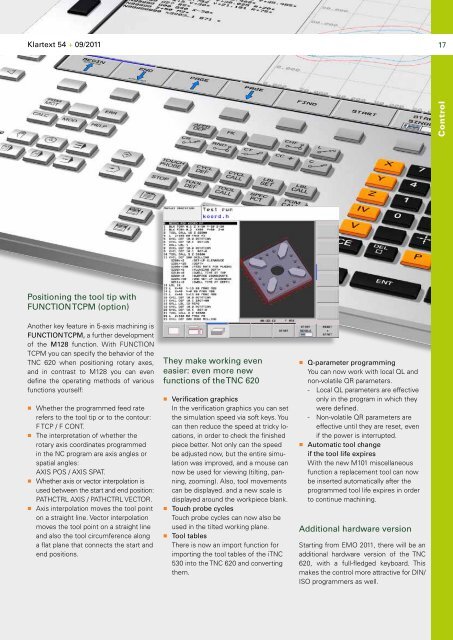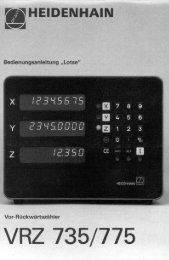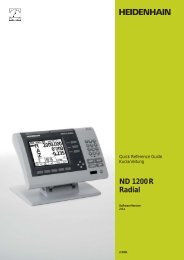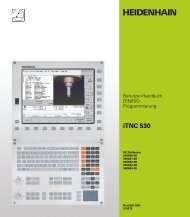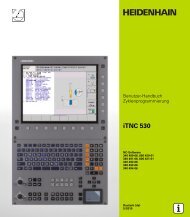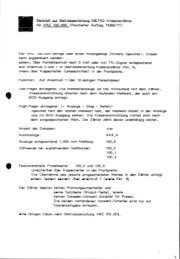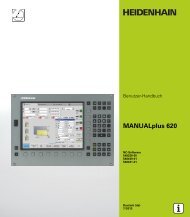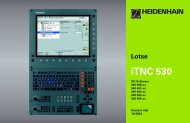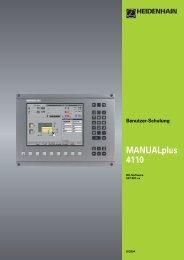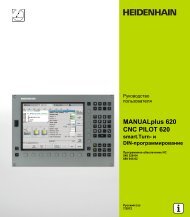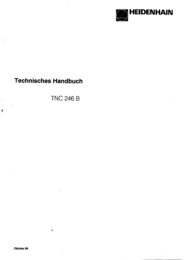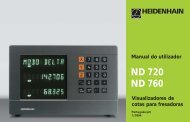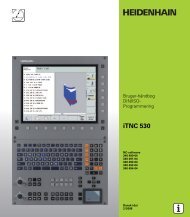Klartext 54 - heidenhain - DR. JOHANNES HEIDENHAIN GmbH
Klartext 54 - heidenhain - DR. JOHANNES HEIDENHAIN GmbH
Klartext 54 - heidenhain - DR. JOHANNES HEIDENHAIN GmbH
You also want an ePaper? Increase the reach of your titles
YUMPU automatically turns print PDFs into web optimized ePapers that Google loves.
<strong>Klartext</strong> <strong>54</strong> + 09/2011<br />
Positioning the tool tip with<br />
FUNCTION TCPM (option)<br />
Another key feature in 5-axis machining is<br />
FUNCTION TCPM, a further development<br />
of the M128 function. With FUNCTION<br />
TCPM you can specify the behavior of the<br />
TNC 620 when positioning rotary axes,<br />
and in contrast to M128 you can even<br />
define the operating methods of various<br />
functions yourself:<br />
■ Whether the programmed feed rate<br />
refers to the tool tip or to the contour:<br />
F TCP / F CONT.<br />
■ The interpretation of whether the<br />
rotary axis coordinates programmed<br />
in the NC program are axis angles or<br />
spatial angles:<br />
AXIS POS / AXIS SPAT.<br />
■ Whether axis or vector interpolation is<br />
used between the start and end position:<br />
PATHCTRL AXIS / PATHCTRL VECTOR.<br />
■ Axis interpolation moves the tool point<br />
on a straight line. Vector interpolation<br />
moves the tool point on a straight line<br />
and also the tool circumference along<br />
a flat plane that connects the start and<br />
end positions.<br />
They make working even<br />
easier: even more new<br />
functions of the TNC 620<br />
■ Verification graphics<br />
In the verification graphics you can set<br />
the simulation speed via soft keys. You<br />
can then reduce the speed at tricky locations,<br />
in order to check the finished<br />
piece better. Not only can the speed<br />
be adjusted now, but the entire simulation<br />
was improved, and a mouse can<br />
now be used for viewing (tilting, panning,<br />
zooming). Also, tool movements<br />
can be displayed. and a new scale is<br />
displayed around the workpiece blank.<br />
■ Touch probe cycles<br />
Touch probe cycles can now also be<br />
used in the tilted working plane.<br />
■ Tool tables<br />
There is now an import function for<br />
importing the tool tables of the iTNC<br />
530 into the TNC 620 and converting<br />
them.<br />
■ Q-parameter programming<br />
You can now work with local QL and<br />
non-volatile QR parameters.<br />
- Local QL parameters are effective<br />
only in the program in which they<br />
were defined.<br />
- Non-volatile QR parameters are<br />
effective until they are reset, even<br />
if the power is interrupted.<br />
■ Automatic tool change<br />
if the tool life expires<br />
With the new M101 miscellaneous<br />
function a replacement tool can now<br />
be inserted automatically after the<br />
programmed tool life expires in order<br />
to continue machining.<br />
Additional hardware version<br />
Starting from EMO 2011, there will be an<br />
additional hardware version of the TNC<br />
620, with a full-fledged keyboard. This<br />
makes the control more attractive for DIN/<br />
ISO programmers as well.<br />
17<br />
Control


